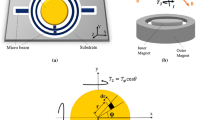Abstract
This article presents a design principle of a novel small-sized compliant optical micro-scanner with two translational (X, Y) and a rotational (θz) degree of freedoms (3-DOFs). A novel normal-stress electromagnetic actuator system is proposed to provide 3-DOFs actuating forces with the working strokes of hundreds of microns for the optical micro-scanner within a very compact structural envelope. The electromagnetic actuator system can not only generate high actuating force density which is similar to solenoid, but also has linear force-current relations along three actuating axes by adopting magnetic configuration design strategy. The theoretical analysis model of the actuator system is derived by using equivalent magnetic circuit method and the actuating force is analyzed through energy store method. Permanent magnet flux leakage and magnetic saturation of stator core in excitation situation are taken into consideration to improve the modelling accuracy. Finite element analysis (FEA) software is utilized to investigate the critical characteristics of the micro-scanner. By FEA comparison, both the theoretical and FEA results show that the actuating force generated by the designed electromagnetic actuator system has a linear relationship with the excitation current. Compare with the normal optical micro-scanner actuated by voice coil motors (VCMs) or piezoelectric (PZT) actuators, the normal-stress based micro-scanner can not only offer movements with three degrees of freedom within a very compact structural envelope, but also achieve high actuating forces which are over 6 times higher than the same sized VCM-actuated micro-scanners. The workspace of this scanner is more than 800 × 800 μm2, which is more than 8 times larger than that of PZT-actuated scanner. The volume of this stage is 60 * 60 * 14 mm3, resulting in a high area-ratio of 1.2%. The cross-axis coupling motion is less than 24 μm at the full primary motion. The resonant frequencies of the two working axes are about 184 Hz.
















Similar content being viewed by others
References
Ahn D, Choi YM, Jeong J (2015) Design of a four-degree-of-freedom nano positioner utilizing electromagnetic actuators and flexure mechanisms. Rev Sci Instrum 86(3):035101
Baranski M et al (2015) Micro-optical design of a three-dimensional microlens scanner for vertically integrated micro-opto-electro-mechanical systems. Appl Opt 54(22):6924–6934
Cai W et al (2010) An alternative flat scanner and micropositioning method for scanning probe microscope. Rev Sci Instrum 81(12):123701–123701-5
Chen F, Lu X, Altintas Y (2014) A novel magnetic actuator design for active damping of machining tools. Int J Mach Tools Manuf 85:58–69
Choi K, Kim D (2006) Monolithic parallel linear compliant mechanism for two axes ultraprecision linear motion. Rev Sci Instrum 77(6):065106
Chu HM, Hane K (2011) Design, fabrication and vacuum operation characteristics of two-dimensional comb-drive micro-scanner. Sens Actuators A 165(2):422–430
Elhady A, Mahmoud MAE, Khalil D (2016) In-plane monolithic microscanner with two synchronized, self-aligned flat mirrors and compliant springs. J Micro/Nanolithogr MEMS MOEMS 15(1):015501
Furlani EP (2001) Permanent magnet and electromechanical devices. Academic Pressa Harcourt Science and Technology Company, San Diego, CA, pp 157
Kim H, Gweon DG (2012) Development of a compact and long range XYtheta(z) nano-positioning stage. Rev Sci Instrum 83(8):085102
Leang KK, Fleming AJ (2009) High-speed serial-kinematic SPM scanner: design and drive considerations. Asian J Control 11(2):144–153
Li H et al (2017) Micro-motion detection of the 3-DOF precision positioning stage based on iterative optimized template matching. Appl Opt 56(34):9435–9443
Lu X (2005) Electromagnetically-driven ultra-fast tool servos for diamond turning. ProQuest Dissertations Publishing
Melcher HHWA (1968) Electromechanical dynamics. Wiley, New York
Merry R et al (2009) Using a walking piezo actuator to drive and control a high-precision stage. IEEE/ASME Trans Mechatron 14(1):21–31
Tuma T, Haeberle W (2014) Dual-stage nanopositioning for high-speed scanning probe microscopy. IEEE/ASME Trans Mechatron 3(19):1035–1045
Wadikhaye SP, Yong YK, Moheimani SOR (2012) Design of a compact serial-kinematic scanner for high-speed atomic force microscopy: an analytical approach. Micro Nano Lett 7(4):309
Acknowledgements
The authors would like to thank the support from the key laboratory of science and technology, National University of Defense Technology.
Funding
National Natural Science Foundation of China (Grant No. 51575423). National Basic Research Program of China (973 Program, Grant No. 2015CB057503).
Author information
Authors and Affiliations
Corresponding author
Ethics declarations
Conflict of interest
The authors declare no conflicts of interest. Ruoyu Tan, as the First Author assure that each Co-author is aware of the disclosures statement of Microsystem Technologies journals and ensures that all required funding and disclosure information is included for all authors.
Additional information
Publisher's Note
Springer Nature remains neutral with regard to jurisdictional claims in published maps and institutional affiliations.
Rights and permissions
About this article
Cite this article
Tan, R., Fan, S. & Fan, D. Design and modeling of a novel electromechanical optical micro-scanner. Microsyst Technol 26, 2715–2728 (2020). https://doi.org/10.1007/s00542-020-04817-6
Received:
Accepted:
Published:
Issue Date:
DOI: https://doi.org/10.1007/s00542-020-04817-6




